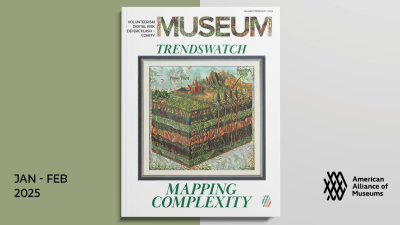CFM guest blogger Robert Janes reviews the AAM forecasting report Demographic Transformation and the Future of Museums. Robert is editor-in-chief of Museum Management and Curatorship, Chair of the Biosphere Institute of the Bow Valley and former president and CEO of the Glenbow Museum, Canada.
Overall, Demographic Transformation and the Future of Museums is an excellent report – focused, rigorous, clear, accessible, and full of important insights and information. I am concerned, however, lest it encourage museums to perpetuate the status quo. Obsessing about the access of new immigrants to consumer opportunities, social position, status and power, for example, strikes me as “fiddling while Rome burns”.
The data from the NEA 2008 Survey of Public Participation in the Arts, summarized in the report, reaffirms the increasing irrelevance of museums. All museum workers should find this quite alarming–the drop in attendance is among the elites who are the predictable supporters of museums. But this has nothing to do with minority populations and, because of this, the decline in attendance should be alerting us to some fundamental concerns about the obvious contemporary relevance and value of museums.
While it raises a number of important issues, the report doesn’t address the unexpected barriers or obstacles that might change our society’s course, such as global warming, acidic oceans, catastrophic weather events, increasing population displacement, global poverty and the assault on the ethnosphere. Personally, I am not pessimistic or apocalyptic about the long-term consequences of our environmental-social irresponsibility, but I do listen to the science and believe that adopting the cautionary principal is the sensible thing to do. In light of this, I don’t see how this report, and the museum field, can afford to ignore the many large-scale issues we confront, all of which also have direct consequences for minority populations.
Skip over related stories to continue reading articleAnd I am dismayed to see the report perpetuate the discussion of museums as purveyors of entertainment or edutainment – “uniqueness and novelty”. I’m always hopeful that some day the museum community will be able to move beyond the idea of “entertaining ourselves to death” (Neil Postman). This report celebrates shopping, movies, and playing video games as important to youth and something museums should be paying attention to. It seems to me that museums, with their inherent value and unique perspective, should be thinking far beyond these materialistic trivialities. It’s high time for all museums to release the grip of consumer culture and start addressing those many issues which actually affect people’s lives.
There are other things in the report I wholeheartedly support. I totally agree with the idea of offering choice in museum exhibits and I wrote about this in detail in The Paradox of Change (1995 and 1997), wherein I discussed the concept of the “museum living room”. The typical museum exhibit has not changed for hundreds of years and it is moribund and ineffective.
The report’s discussion of the “First Globals” (a new demographic marker) is most interesting. Globalism has revealed its fundamental flaws (wealth disparity, exploitation of developing countries, destruction of cultural diversity, etc.) to all but the corporatists, so this demographic may prove to be completely irrelevant as the shift to the local/community becomes a necessity, as many pundits and experts are already predicting. Complex industrial and technocratic systems do not have the resilience to adapt to the socio-environmental changes already underway, as has been proven time and again (Katrina, BP oil blowout, destruction of the fisheries, Iraq war, etc.).
The New York Hall of Science, featured in the report as a case study, is a wonderful example of addressing the question of “why” – getting an introduction to science and attaining advanced education at a rate five times higher than the general population. Their Science Career Ladder has a much deeper purpose than entertaining culturally diverse youth and the youth are responding accordingly. This is an excellent example of a conscious and socially responsible museum program.
Overall, this is an excellent report for what it attempts to do. To me, however, it is somewhat of a distraction from the task at hand—a bit like finalizing your home renovation plans when the hurricane is due to make landfall the day after tomorrow. If the bulk of museums were doing relevant and meaningful work that was truly engaged with their communities, demographics would be irrelevant. But museums continue to cling to their elitist support and internally driven agendas.
In the final analysis, Demographic Transformation and the Future of Museums is valuable and important because it makes an indisputable case for dethroning the typical elitist museum. Cultural inclusivity is an essential first step in the long-term survival of museums, but time is growing short. It is no longer sufficient to be concerned with growing audiences – irrespective of their ethnic origin. It’s time to ask some important questions about why museums do what they do, and how their unique resources can be brought to bear on community interests and aspirations.
If you would like to comment on the Demographic Transformation report, please write me at futureofmuseums@aam-us.org. We would love for you to share your opinions!









Comments